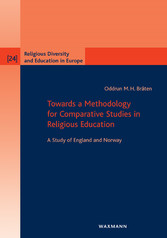Suchen und Finden
Service
Towards a Methodology for Comparative Studies in Religious Education - A Study of England and Norway
Mehr zum Inhalt

Towards a Methodology for Comparative Studies in Religious Education - A Study of England and Norway
Buchtitel
1
Foreword
5
Contents
10
Acknowledgments
14
Abstract
15
Abbreviations
16
1. Introduction
19
1.1 A systematic approach to comparative studies in Religious Education
19
1.2 The cases: RE in England and Norway
20
1.3 Different school systems
23
1.4 Scope and limitations
24
1.5 Main research questions
25
1.6 Summary and Conclusion
26
2. Towards a Methodology for Comparative Religious Education
27
2.1 Introduction
27
2.2 Comparative studies in related fields
27
2.3 Pioneering work in the field of RE
32
2.4 Challenges in comparative studies in RE
35
2.5 Methodological considerations
38
2.6 Is this a new methodology?
40
2.7 National imaginaries and supranational processes
40
2.8 Three dimensions in comparative studies
42
2.9 The supranational dimension
45
2.10 A template for comparative studies in RE
50
2.11 Summary and Conclusion
52
3. Societal Level: Themes within Academic Debates about Religious Education in England and Norway
54
3.1 Introduction
54
3.2 The contribution of ‘secular’ religious studies to the development of multifaith approaches to RE in England and Norway
55
3.3 The institutional basis for RE research
61
3.4 Can we talk about ‘traditions’ for pedagogy of RE?
63
3.5 The reading of two ‘power texts’ by looking for characteristics of academic debate in England and Norway
67
3.6 The supranational dimension in academic debates on RE today
77
3.7 Summary and conclusion
80
4. Institutional Level: Legal and Policy Developments in England and Norway
81
4.1 Introduction
81
4.2 The Legal Framework
81
4.3 Laws regulating RE in state schools
82
4.4 Laws regulating the right to opt out
85
4.5 The Norwegian law suits
86
4.6 Religion in laws regarding schooling in general
87
4.7 Comparative discussion on legal issues
88
4.8 Introducing QCA 2004 and UD 2005
93
4.9 QCA 2004
94
4.10 UD 2005
96
4.11 Comparative remarks regarding layout and structure
98
4.12 The place in the school curricula
99
4.13 Comparative points
100
4.14 Structure and content of RE in England and Norway exemplified through QCA 2004 and UD 2005
101
4.15 Comparative discussion regarding structure and content
106
4.16 Concluding discussion
108
4.17 Summary and Conclusion
112
5. Religious Education in Practice:Introduction to Case Studies from England and Norway
113
5.1 Introduction
113
5.2 Representation and national imaginaries
113
5.3 Different styles of civility in the school systems
116
5.4 Characteristics of the schools
121
5.5 Location of the schools and characteristics of the school populations
124
5.6 Do classroom activities reflect different national styles?
125
5.8 Reflecting on the empirical studies in the methodology
134
5.9 Summary and Conclusion
136
6. Instructional Level: Teachers’ Perspectives
137
6.1 Introduction
137
6.2 The teachers and their contexts
138
6.3 Describing their school and its RE
139
6.4 Aims of RE
141
6.5 The importance of RE
142
6.6 National aims and local adjustments
146
6.7 Text books and schemes of work
148
6.8 Content of teaching
150
6.9 Social enculturation gives nationally distinctive patterns in teaching?
152
6.10 Learning about and from religion
153
6.11 Reflecting on multifaith RE as integrative RE
156
6.12 Is RE creating otherness?
158
6.13 How is ‘Norwegianness’ and ‘Englishness’ imagined?
159
6.14 Summary and conclusion
160
7. Experiential Level: Pupils’ Perspectives
164
7.1 Introduction
164
7.2 The pupils and their context
165
7.3 Which modernities?
168
7.4 Aims of RE
172
7.5 Content of learning
175
7.6 What can explain the difference in quality of factual knowledge?
176
7.7 Religion in Britain? Norwegian religion?
178
7.8 Learning about and from religion
181
7.9 What kind of imaginary would be inclusive?
184
7.10 Summary and conclusion
187
8. Concluding Discussion
190
8.1 Introduction
190
8.2 A systematic approach to comparative RE
190
8.3 Is this a general model, a template for comparative studies?
191
8.4 Obstacles and limitations
193
8.5 Results: Examples of findings
194
8.6 Different national styles
196
8.7 Inclusive RE and construction of otherness
200
8.8 Summary and conclusion
205
Appendix 1: Interview Schedules
208
Appendix 2: Norwegian Legal Texts
213
Appendix 3: The Teachers’ Educational Backgrounds
217
References
219
Alle Preise verstehen sich inklusive der gesetzlichen MwSt.








